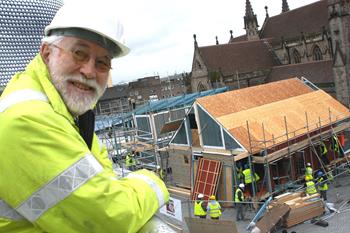No more Noisy Neighbours
Acoustic Flanking Sound According to Knauf’s Charles Johnston, around half the UK population says noise affects their quality of life; 22% of people cite noise as the most common cause of problems with neighbours. Sound transmission through separating walls involves not only direct sound but also flanking sound. Acoustic flanking is a sound which travels in any direction other than directly through the separating elements. Reasons for Failure Approved Document E (England & Wales) of the Building Regulations require new-build separating walls and floors to achieve a minimum acoustic performance of 45 dB DnT,w + Ctr. In conversion projects this must be 43 dB DnT,w + Ctr. The NHBC says the most common causes for failure to reach these levels are poor workmanship, incorrect material supply and incorrect design detailing in the specification process. Residential Weak Points Most common is the joint between interior partitions and the external envelope. Here several components must be perfectly allied to reach Part E performance. This is difficult to resolve as the internal partitioning may be sourced from different manufacturers and installed by different contractors to those providing the external envelope. Knauf Engineers Complete Façade Solution This incorporates both the exterior infill panel system and interior partitioning. It is the first in the construction industry to be designed and supplied by a single manufacturer in an effort to simplify the specification and installation process. This “ThroughWall Solution” is a simple specification, designed for both steel frame and concrete frame systems. It offers architects a single point of contact to provide the complete external and internal specification. Any problems can be solved by Knauf, rather than blame being shifted from one manufacturer to another. Accurate design drawings ensure contractors know exactly what to expect, supported by a range of insurance-backed Knauf warranties. Combined Acoustic, Fire, Thermal and Airtightness Knauf’s full system comprises Internal Plasterboard, Mineral Wool Insulation, Solid Steel Frame System (SFS), Windliner and PIR Insulation. Infill panels can be finished in a number of external facade materials including a range of Knauf renders. ThroughWall gives optimal acoustic performance with excellent fire, thermal and airtightness performance, as well as providing protection against the elements with Knauf Windliner. Wide range of applications Ideal for use in residential developments, the system can also be specified for commercial, healthcare, education and office buildings for both new-builds and refurbishments. Recent testing and certification covers use in buildings taller than 18m. Knauf PIR Insulation has met the requirements set out in Annex B of BRE and has successfully passed the test as per British Standard 8414-2. The benefit of using PIR insulation above 18m is that, because of its thinner profile, the external envelope has a reduced thickness, providing more internal floor space. Technical Expertise Whatever your project, the chances are that it will need some degree of technical expertise for it to be buildable. Conceptual designs can be made more ‘buildable’, Building Regulation compliant, and cost effective if the technical structural aspects have been addressed as the design is worked up. Ideally a ‘team working’ approach is desirable and can have significant benefits, especially in the area of energy efficiency.Visit the Benfield ATT Group website for more information on No more Noisy Neighbours





